Paula Garner always wanted to be a farmer. As an adult, the opportunity arose to care for a small flock of Santa Cruz sheep, a critically endangered breed. Due to her husband’s job moves, they have transported their animals from California to Louisiana to Connecticut. The Garners have one of the largest flocks of Santa Cruz sheep currently in existence.
You are breeding sheep to conserve and restore this endangered breed. How did you learn about them in the first place?
My family was living as caretakers on a ranch in California, with a farm-based education program. At a board meeting, I was asked to find a rare breed of sheep to bring into the program.
The Swiss Village Foundation in Rhode Island is working to revive endangered and rare breeds of various animals, and they gave me information about Santa Cruz Island sheep. I’d never heard of them. Santa Cruz Island is off the coast of California near Los Angeles. When I called the Island, they said, “Oh no, we don’t have any of those here anymore, thank goodness!” I started researching their story, and my heart went out to this poor little flock!
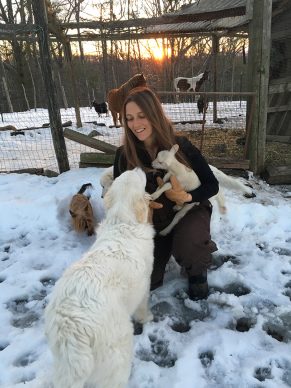
Paula Garner
What had happened to the sheep?
In the 1970s, Santa Cruz Island was purchased by a Nature Conservancy. There used to be thousands and thousands of these sheep, and the Conservancy decided that the sheep were killing the native plants there. They actually slaughtered over 37,000 of these sheep and just put them in these large burn piles. They weren’t using the meat or the wool or anything.
The Livestock Conservancy, which works to preserve lots of different breeds of farm animals, got word and thought the Santa Cruz was probably a different breed. So they went over and found that it is, in fact, its own strain. It was a mix of breeds that they’re not sure of and they don’t know for how long, but it has become its own breed with its own specific and unique genome.
The Nature Conservancy would let them take only ten ewes and two rams to preserve, and only lambs. They could test the mother to make sure everything was okay, but it was heartbreaking that they had to kill the mother to save the baby. Later, other people were allowed to get the few that were left, but they were eventually gone from the island.
As I was researching, I saw that Santa Cruz sheep in the 1940s and 50s had sold for top dollar at the market. But since they were wild and feral and left to their own devices, now people see them as worthless. That just kind of ate at me, because people’s opinion made it that suddenly these sheep had no purpose or value. They still did! I thought, all right, I am going to help them get a purpose.
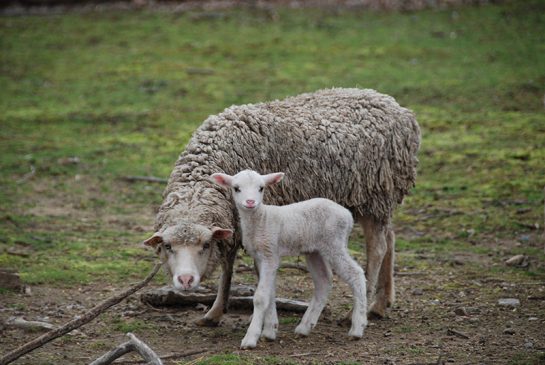
Santa Cruz sheep
What makes Santa Cruz sheep unique from other breeds?
These are the rarest breed of sheep! They are the most critically endangered out of all the breeds of sheep. There’s only about 150 of them left.
One of the Santa Cruz traits is that they’re extremely parasite resistant. I don’t have to use chemical wormers to sustain my flock, whereas typically the meat that you’re eating used a lot of chemicals to keep that sheep alive and well. We’ve lost sheep to a couple of little things here and there, but mainly we’ve only had predator loss with our flock. Also, unfortunately, natural disasters. We had a big wind storm that knocked something down and killed a sheep. But we don’t really lose them to parasites or diseases.
They’re nice and small, I can manage them myself. Their rams are not aggressive. Some breeds have very aggressive rams and if you’re a little kid, it’ll take you out. I don’t have to worry about that. My kids can go in the ram pen and they’re just fine. Those traits to me are very valuable.
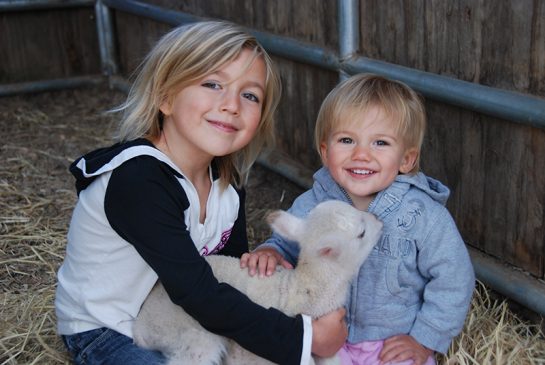
Paula’s children with a Santa Cruz lamb
What about their wool?
Santa Cruz wool has an incredibly elastic value to it so it’s really stretchy. This is one of the only breeds that you can get a stretchy yarn from without blending nylon to it. It’ll stretch to about one-third – most wool won’t stretch like that. It’s also a soft wool. My fleeces are finer because I don’t grain-feed, I grass-feed. The amount of protein will make the wool more coarse or more fine.
Do you sell the wool? I have friends who spin their own yarn and knit. It seems like there would be a demand for this nice of a fleece.
The challenge is they don’t grow much wool because they were a feral breed. They shed their wool as well. About half of our flock shed the wool, the other half won’t and so they do need a shearer.
The ones that shed – do you collect that wool or is it gone at that point?
It depends. There are different sections of wool, like the neck, the back, and different ones are of more value. You typically separate them when you’re making small-batch wool. Most of the time we don’t save it.
The sheep adapted over time. They don’t have wool on their faces. One of the breeds they originated from had wool on their faces and that went off over time. The breed also used to have wool on their bellies. They’re starting to get it back because we’re here in New England. It’s not great to be preserving them here because you want to have them in their natural state, which is hot and dry. But unfortunately, we didn’t find any stewards while we were in California. So they are making certain adaptations. They don’t get wool on their legs but they do now keep the wool on their belly a little bit more but it will still come off in the summer.
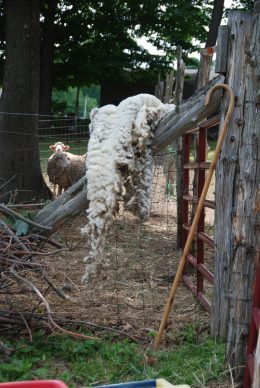
Santa Cruz sheep wool
You were in California and caretaker of an education ranch that wanted you to find some rare sheep to have on the property. Then what?
After I called Santa Cruz Island and was told they had no more sheep, the Swiss Village Foundation gave me a local breeder’s information, Mr. Stanley. He loaned us two pregnant ewes and one that had just had a baby. I kept telling Mr. Stanley I didn’t know anything about it, and he just said we’d be okay, he’d talk us through it. He was really great to work with.
And sure enough, we’d walk out there one day and there would be a lamb. The mother would have cleaned it off and fed it – Santa Cruz sheep have good mothering instincts because it’s survival of the fittest. If they didn’t take care of their baby, the baby was just going to die, which meant that line wasn’t going to go on. These sheep have such great instincts so it was great for beginners.
So first, you had a couple as loaner sheep but now you own the entire flock. How did that go?
My husband was in the military and got orders to go from California to Louisiana. Mr. Stanley said that he’d really like us to take the sheep, he was getting too old for this. We wanted to help him out because he couldn’t take care of this flock anymore, but we had some trouble getting land in Louisiana so we thought maybe we would get them in the summer. We called Mr. Stanley and he said, “They’re getting eaten by a mountain lion. I’d really like you to take them now.”
I wanted to take the sheep, but you know me, I like to do crazy things. Phil prayed about it and said, “I think we should take the sheep.” It was his choice in the end. When we took the sheep, we left three there for the education farm. We took only 17.
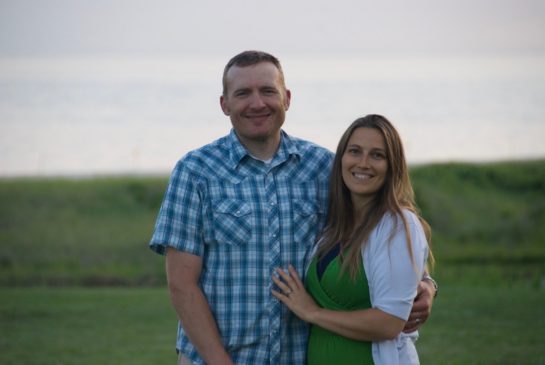
Paula Garner and her husband Phil
What happened to the last three sheep?
It’s actually a heartbreaking story, and I really wanted to go back and get them but we didn’t have the funds. Mr. Stanley kept back the matriarch of the flock because maybe the trip wouldn’t be so good for her. When I called him, he said he had never seen anything like it – she was so grief stricken and the ram was trying to console her. Mr. Stanley had never seen such behavior out of a ram before – just trying to console her, being close to her, walking around with her everywhere and rubbing up against her, not in a breeding way – she was already bred – it was solely to try to calm her. It broke my heart!
And now I have my current problem, all these old ewes. Typically, you dispose of your old ewes, but I can’t do it. That story made me feel like, I don’t want to be disposed of when I’m old! These older ewes still want to live! The way I see it is that they’re still teaching the others. For the first three years, they learn a lot from their mother. I let them naturally wean – I don’t separate mine at six months like most people do. That way, they can still learn about poisonous plants and things like that. I was so stressed at first about all these poisonous plants for sheep, but these sheep can actually be around poisonous plants and won’t eat them because they teach other. You can see them push a lamb off of it.
Since you’re not separating them at six months, it seems like the mothering instinct is staying strong.
We have struggled with a few because you have to breed everything here. If you have an animal with really poor mothering instincts, you wouldn’t breed it anymore. Unfortunately, we do have to breed it because we need all the genetics. So we do have a few sheep that – man, it’s a pain to help them realize the joy of motherhood. They get postpartum! It’s a real thing! It happens to sheep too, so we help them along. That means holding her and letting the baby nurse, and hoping that oxytocin is strong enough that she’ll start doing it herself. It does help with the mothering instinct. We would probably have more poor mothers if we didn’t do it that way.
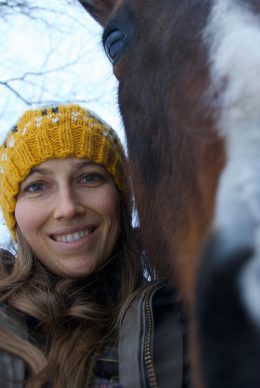
Paula Garner
How long were you in Louisiana?
A year and a half. We built up this farm and I loved what we had going there. I combined doing field trips with another farm to teach students about sheep and our rare breed, and I had probably 4000 kids on these field trips. It was fun.
As nice as it would have been to stay, because we could have afforded to live and farm there in Louisiana, we felt like Phil should move on and pursue his education. He didn’t have a degree that would set him up for Occupational Therapy so we came here to Connecticut where I grew up, so he could go to Boston University.
Where did you put the sheep as you were moving from state to state? That’s not like packing up a moving truck with a bunch of boxes and putting them in a rental apartment that you can find online.
I went to Louisiana to house-hunt with my dad. We drove to this house and I told my dad, you’re not supposed to just drive up unannounced. But my dad doesn’t listen, he still drove up the driveway and sure enough, they’re standing right there. The couple showed us around and said to call if we ever needed anything, so when we were in California trying to arrange everything with the sheep, I did call to ask if they would be open to us grazing sheep on their property while we looked for some land. Sure! I asked what he would charge us – he said, “I reckon I wouldn’t charge you nothin’.” It was really miracle after miracle after miracle.
We went to Louisiana, and when we pulled up to unload the sheep, the farmer said, “Ya know, I’ve got an RV plug over there. Why don’t you just plug in and stay here?” He had twenty gorgeous acres on top of this hill which was a huge blessing because we got to be there right with the sheep. Charles and Nettie became like our little grandparents. We thought it was going to be a month or two but it took five months before we got our own land.
When we came here to Connecticut, my dad helped us again by talking to Juan, who he had worked with previously on construction projects, and he had a farm. When we were getting ready to move up here, it was arranged for us to be caretakers of his property in exchange for keeping our sheep here.
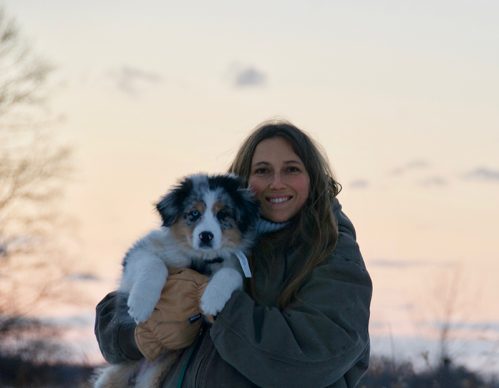
Paula Garner
You have a website, and I saw on it something about sponsoring sheep.
Yep! That’s new. I realized that if I put it out there, that other people can help sponsor these sheep, this breed really will continue to grow. We just got a couple of sponsors and we were able to buy plywood to give the sheep an actual wood structure this year. They used to be in tents. The more sponsors we get, the more we can do for these sheep. I feel like these sheep have had a really rough life, a really rough story, and it would be just great for them to have a nice ending!
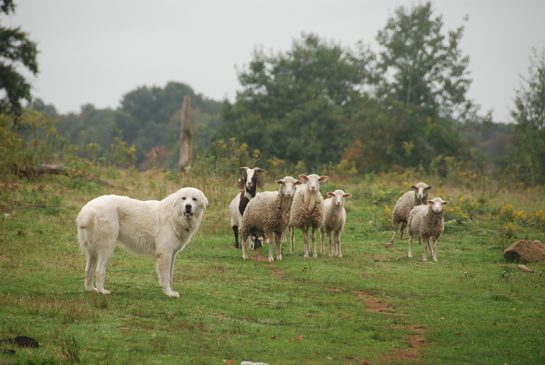
Santa Cruz sheep on the Garner farm
You’ve given a presentation about the Santa Cruz breed at the sheep and wool festival in Rhinebeck, New York. What was your message there?
These are diamonds in the rough. This is the toughest breed, the most resilient. We should save this breed mostly because I feel like God works really hard to give us diversity. Let’s preserve it, people! Let’s value it! Well, we don’t know how hard God worked, maybe He didn’t, but I think He did. It took hundreds of years to make this, we can’t recreate this. We have so many things that we can create, but we cannot recreate this breed overnight. It will take hundreds of years. We don’t even have what one of the other breeds might have been. Some sort of Churro, maybe. There are Native American findings on that island, so they may have brought sheep there. That breed is just gone. We don’t have the foundation breeds to make this happen again. We don’t have a hundred years to let things run feral on an island and see what lives. This is something that has history, it has value. We’ve seen with cloning that it’s just best to keep things the way nature intended. To keep it going would be the healthiest line. Working with nature is tricky, but you see how amazing it is when you really plunge into it. There are so many things that I didn’t know of, wasn’t aware of, or did not appreciate until I started farming.
That’s why we felt like we needed to do something. We were there in California, and I just felt really drawn to them. Everyone asks, why did you pick Santa Cruz sheep? I don’t feel like I chose them. I really feel like the Santa Cruz picked me more than I picked them.
Any final words?
Save the sheep!
At A Glance
Name: Paula Garner
Location: South Glastonbury, Connecticut
Age: 35
Children: 4 kids – Izzy, Will, Lidia, Jonas
Occupation: Farm-based educator
Schools Attended: Brigham Young University
Favorite Hymn: Come, Thou Fount of Every Blessing
Website: www.hiddenhillshomestead.org
Interview Produced by Trina Caudle
